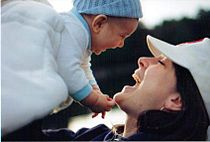
Back التعلق في الأطفال Arabic دلبستگی کودک Persian Kiintymyssuhdeteoria Finnish תאוריית ההתקשרות HE Vreemdesituatietest Dutch Style przywiązania się u dzieci Polish Anknytning Swedish 依附理論 Chinese

Attachment in children is "a biological instinct in which proximity to an attachment figure is sought when the child senses or perceives threat or discomfort. Attachment behaviour anticipates a response by the attachment figure which will remove threat or discomfort".[1][2][3] Attachment also describes the function of availability, which is the degree to which the authoritative figure is responsive to the child's needs and shares communication with them. Childhood attachment can define characteristics that will shape the child's sense of self, their forms of emotion-regulation, and how they carry out relationships with others.[4] Attachment is found in all mammals to some degree, especially primates.
Attachment theory has led to a new understanding of child development. Children develop different patterns of attachment based on experiences and interactions with their caregivers at a young age. Four different attachment classifications have been identified in children: secure attachment, anxious-ambivalent attachment, anxious-avoidant attachment, and disorganized attachment. Attachment theory has become the dominant theory used today in the study of infant and toddler behavior and in the fields of infant mental health, treatment of children, and related fields.
- ^ Prior & Glaser (2006) Understanding Attachment and Attachment Disorders, London: JKP, p.17
- ^ Bowlby, J. (1960). "Separation Anxiety". Int J Psychoanal. 41: 89–113. PMID 13803480.
- ^ Tronick, Morelli, & Ivey, 1992, p.568. "Until recently, scientific accounts ... of the infant's early social experiences converged on the view that the infant progresses from a primary relationship with one individual... to relationships with a growing number of people... This is an epigenetic, hierarchical view of social development. We have labeled this dominant view the continuous care and contact model (CCC...). The CCC model developed from the writings of Spitz..., Bowlby..., and Provence and Lipton... on institutionalized children and is represented in the psychological views of Bowlby...[and others]. Common to the different conceptual frameworks is the belief that parenting practices and the infant's capacity for social engagement are biologically based and conform to a prototypical form. Supporters of the CCC model generally recognize that the infant and caregiver are able to adjust to a range of conditions, but they consider the adjustments observed to reflect biological variation. However, more extreme views (e.g., maternal bonding) consider certain variants as nonadaptive and as compromising the child's psychological development. Bowlby's concept of monotropism is an exemplar of the CCC perspective..." (Tronick, Morelli, & Ivey, 1992, p. 568).
- ^ Kayastha, P. (2010). Security of attachment in children and adolescents. Bangalore: Elsevier B.V.
© MMXXIII Rich X Search. We shall prevail. All rights reserved. Rich X Search